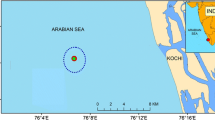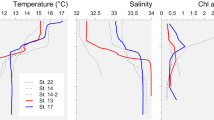Abstract
Although planktonic copepods are major suspension feeders in the sea, the impact of their grazing pressure upon red-tide flagellates has not been fully investigated. In the present study, the grazing of adult females of several copepod species is examined using three food types: viz. natural suspended particles, natural suspended particles mixed with cultured Chattonella antiqua, and cultured C. antiqua. The functional response on C. antiqua was investigated for five species of copepods (Acartia erythraea, Calanus sinicus, Centropages yamadai, Paracalanus parvus and Pseudodiaptomus marinus). Ingestion rates increased linearly with increasing cell concentrations until a maximum level was reached, beyond which the rates were constant. This cell concentration was higher for larger copepods. The weight-specific maximum ingestion rates were higher in the small species. In general, copepods tended to feed selectively on larger particles when feeding on natural particles. This tendency was strongest in a simulated red-tide environment. Thus, it can be surmised that copepods may selectively graze on C. antiqua during the outbreak of a red tide. Grazing pressure by the natural copepod community in Harima Nada, the Inland Sea of Japan, was calculated by integration of the laboratory determined feeding rates and field measurements of zooplankton biomass. The daily removal rate was 3.4 to 30.8% (mean: 12.3%) of C. antiqua biomass at 20 cells ml-1 and decreased to 0.6–4.3% (mean: 1.8%) at 500 cells ml-1. Therefore, the grazing pressure by the copepod community is important at the initial stage of the red tide.
Similar content being viewed by others
Literature cited
Checkley, D. M., Jr.: The egg production of a marine planktonic copepod in relation to its food supply: laboratory studies. Limnol. Oceanogr. 25, 430–446 (1980)
Conover, R. J.: Transformation of organic matter. In: Marine ecology, Vol. IV, Dynamics, pp 221–499. Ed. by O. Kinne. New York: Wiley 1978
Corner, E. D. S., R. N. Head and C. C. Kilvington: On the nutrition and metabolism of zooplankton. VIII. The grazing of Biddulphia cells by Calanus helgolandicus. J. mar. biol. Ass. U.K. 52, 847–861 (1972)
Dagg, M. J. and J. T. Turner: The impact of copepod grazing on the phytoplankton of George Bank and the New York Bight. Can. J. Fish. aquat. Sci. 39, 979–990 (1982)
Dagg, M. J., J. Vidal, T. E. Whitledge, R. L. Iverson and J. J. Goering: The feeding, respiration, and excretion of zooplankton in the Bering Sea during a spring bloom. Deep-Sea Res. 29, 45–63 (1982)
Fiedler, P. C.: Zooplankton avoidance and reduced grazing response to Gymnodinium splendens (Dinophyceae). Limnol. Oceanogr. 27, 961–965 (1982)
Fiedman, M. M.: Comparative morphology and functional significance of copepod receptors and oral structures. In: Evolution and ecology of zooplankton communities, pp 185–197. Ed. by W. C. Kerfoot, London: Univ. Press New England 1980
Frost, B. W.: Effects of size and concentration of food particles on the feeding behavior of the marine planktonic copepod Calanus pacificus. Limnol. Oceanogr. 17, 805–815 (1972)
Frost, B. W.: Feeding processes at lower trophic levels in pelagic communities. In: The biology of the oceanic Pacific, pp 59–77. Ed. by C. B. Miller, Corvallis: Oregon State Univ. Press 1974
Forst, B. W.: Grazing. In: The physiological ecology of phytoplankton, pp 465–491. Ed. by I. Morris. Oxford: Blackwell 1980
Gibson, V. R. and G. D. Grice: Developmental stages of Pontella meadii Wheeler (Copepoda: Calanoida). J. exp. mar. Biol. Ecol. 63, 81–92 (1982)
Imai, I., K. Itoh and M. Anraku: Distribution of dormant cells of Chattonella in Harima-Nada, eastern Seto Inland Sea, and temperature characteristics of germination. Bull. Plankton Soc. Japan 31, 35–42 (1984) (in Japanese with English abstract)
Itoh, K.: A consideration of feeding habits of planktonic copepods in relation to the structure of their oral parts. Bull. Plankton Soc. Japan 17, 1–10 (1970) (in Japanese with English abstract)
Iwasaki, H.: Studies on the red tide flagellates. IV. On Eutreptiella sp. and Exuviaella sp. appeared in Bingo-Nada, the Seto Inland Sea, in 1970. J. Oceanogr. Soc. Japan 17, 152–157 (1971) (in Japanese with English abstract)
Iwasaki, H.: Physiological ecology of red tide flagellates. In: Biochemistry and physiology of Protozoa, Vol 1, pp 357–393 Ed. by M. Levandovsky and S. H. Hunter. New York: Academic Press 1977
Kiørboe, T., F. Møhlenberg and H. Nicolajsen: Ingestion rate and gut clearance in the planktonic copepod Centropages hamatus (Lilljeborg) in relation to food concentration and temperature. Ophelia 21, 181–194 (1982)
Kishi, M., S. Ikeda, T. Hirano and A. Nishimura: Numerical modeling of red tide ecosystem. Bull. cstl Oceanogr. 22, 109–118 (1985) (in Japanese)
Marshall, S. M.: Respiration and feeding in copepods. Adv. mar. Biol. 11, 57–120 (1973)
Mullin, M. M. and E. R. Brooks: Some consequences of distributional heterogeneity of phytoplankton and zooplankton. Limnol. Oceanogr. 21, 784–796 (1976)
Nakamura, Y.: Ammonium uptake kinetics and interactions between nitrate and ammonium uptake in Chattonella antiqua. J. Oceanogr. Soc. Japan 41, 33–38 (1985)
Nakamura, Y. and M. M. Watanabe: Growth characteristics of Chattonella antiqua (Raphidophyceae). Part 1. Effect of temperature, salinity, light intensity and pH on growth. J. Oceanogr. Soc. Japan 39, 110–114 (1983a)
Nakamura, Y. and M. M. Watanabe: Growth characteristics of Chattonella antiqua. Part 2. Effects of nutrients on growth. J. Oceanogr. Soc. Japan 39, 151–155 (1983b)
Nakamura, Y. and M. M. Watanabe: Nitrate and phosphate uptake kinetics of Chattonella antiqua growth in light/dark cycles. J. Oceanogr. Soc. Japan 39, 167–170 (1983c)
Okaichi, T.: Marine environmental studies on outbreaks of red tides in neritic waters. J. Oceanogr. Soc. Japan 39, 267–278 (1983) (in Japanese with English abstract)
Ono, C. and T. Takano: Chattonella antiqua (Hada) comb. nov., and its occurrence on the Japanese coast. Bull. Tokai Reg. Fish. Res. Lab. 102, 93–100 (1980)
Paffenhöfer, G.-A.: Cultivation of Calanus helgolandicus under controlled conditions. Helgoländer wiss. Meeresunters. 20, 346–357 (1970)
Paffenhöfer, G.-A.: Feeding, growth, and food conversion of the marine planktonic copepod Calanus helgolandicus. Limnol. Oceanogr. 21, 39–50 (1976)
Poulet, S. A.: Grazing of Pseudocalanus minutus on naturally occurring particulate matter. Limnol. Oceanogr. 18, 564–573 (1973)
Poulet, S. A. and P. Marsot: Chemosensory grazing by marine calanoid copepods (Arthropoda: Crustacea). Science 200, 1403–1405 (1978)
Poulet, S. A. and P. Marsot: Chemosensory feeding and foodgathering by omnivorous marine copepods. In: Evolution and ecology of zooplankton communities, pp 198–218. Ed. by W. C. Kerfoot. London: Univ. Press New England 1980
Poulet, S. A. and G. Quellett: The role of amino acids in chemosensory swarming and feeding of marine copepods. J. Plankton Res. 4, 341–362 (1982)
Richman, S., D. R. Heinle and R. Huff: Grazing by adult estuarine calanoid copepods of the Chesapeake Bay. Mar. Biol. 42, 69–84 (1977)
Roman, M. R.: Feeding of the copepod Acartia tonsa on the diatom Nitzschia closterium and brown algae (Fucus vesiculosus) detritus. Mar. Biol. 42, 149–155 (1977)
Schnack, S. B.: On the feeding of copepods on Thalassiosira partheneia from the Northwest Africa upwelling area. Mar. Ecol. Prog. Ser. 11, 49–54 (1983)
Steele, J. H.: The structure of marine ecosystems, 128 pp. Oxford: Blackwell 1974
Tsuda, A. and T. Nemoto: Feeding of the marine copepod Acartia clausi on cultured red-tide phytoplankton. Bull. Plankton Soc. Japan 31, 79–80 (1984)
Uye, S.: Length-weight relationships of important zooplankton from the Inland Sea of Japan. J. Oceanogr. Soc. Japan 38, 149–158 (1982)
Uye, S. and S. Kasahara: Grazing of various developmental stages of Pseudodiaptomus marinus (Copepoda: Calanoida) on naturally occrring particle. Bull. Plankton Soc. Japan 30, 147–158 (1983)
Yoshida, Y. and K. Kawaguchi: Buoyancy and phototaxis of Chattonella antiqua (Hada) Ono. Bull. Plankton Soc. Japan 30, 11–19 (1983) (in Japanese with English abstract)
Author information
Authors and Affiliations
Additional information
Communicated by M. Anraku, Hiroshima
Rights and permissions
About this article
Cite this article
Uye, S. Impact of copepod grazing on the red-tide flagellate Chattonella antiqua . Marine Biology 92, 35–43 (1986). https://doi.org/10.1007/BF00392743
Accepted:
Issue Date:
DOI: https://doi.org/10.1007/BF00392743




